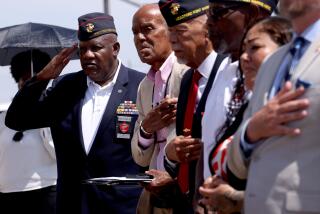War Heroism Rewarded--32 Years Later
- Share via
WASHINGTON — More than 32 years ago, a young Navy corpsman named Robert R. Ingram braved the fire of a raging battlefield to aid his wounded comrades, even as he got shot through the face, hand, knee and groin.
On Friday, Ingram walked into the White House, where President Clinton placed on him a blue-ribboned Medal of Honor, the nation’s highest award for military valor.
“On that battlefield so many years ago, Robert Ingram performed truly heroic deeds and asked for nothing in return,” Clinton said. “At long last, it is time to honor him.”
The medic was injured so gravely that others thought he was killed. He could have left the battlefield but didn’t, crawling again and again to his fallen buddies, taking bullets not once but four times. As Clinton recounted that long-ago display of courage, Ingram, 53, who works at a medical clinic in Jacksonville, Fla., stood at his side, an impassive look on his face.
“His vital signs dropped to the point that he was tagged ‘killed in action’ and placed in the dead pile,” Clinton said at a somber ceremony in the state dining room. “But as you can see, he did not die.”
Ingram’s commander recommended him for the Medal of Honor at the time. But in a classic bureaucratic mix-up, the paperwork somehow got lost. A few years ago, when his buddies learned at a reunion that he had never been commended for bravery in the battle, they vowed to resurrect the matter. Their efforts won a sympathetic hearing in Congress, which last year approved the award and waived the legal requirement that a Medal of Honor be approved within two years of the act of heroism.
“We don’t know how his citation got lost all those years ago,” said Clinton, “but we do know why he’s here today, because his friends never forgot what he did for them.”
Even in the annals of battlefield bravery, Ingram’s tale is striking. On March 28, 1966, Ingram was just 21, a rifle-carrying medic with a platoon of Marines on a ridge in Quang Ngai province. All at once, a spasm of enemy fire lacerated a tree line. Ingram’s citation relates what happened next:
“In moments, the platoon was decimated. Oblivious to the danger, Petty Officer Ingram crawled across the battlefield to reach a downed Marine. As he administered aid, a bullet went through the palm of his hand.
“Calls for ‘corpsman’ echoed across the ridge. Bleeding, he edged across the fire-swept landscape, collecting ammunition from the dead and administering aid to the wounded.”
At one point, a North Vietnamese soldier shot Ingram in the head. The bullet entered beneath his right eye, went through his sinuses and exited at the left side of the skull where the jaw attaches. Ingram killed his attacker with two rounds from his M-14.
For hours, Ingram, ignoring his own wounds, “pushed, pulled, cajoled and doctored his Marines,” the citation said. “Enduring the pain from his many wounds, and disregarding the probability of his own death, Petty Officer Ingram’s gallant actions saved many lives.”
The Vietnam veteran and Clearwater, Fla., native, who sports a neatly trimmed white beard, last year told a Jacksonville newspaper that he was more gratified by the renewed unity of his old outfit than by the prestigious honor they were advocating on his behalf.
“This is so much bigger for me than receiving a medal,” he said of his comrades’ effort.
“We have formed a closeness with each other that was exactly like it was when we left each other. It’s like we were there yesterday.”
More to Read
Sign up for Essential California
The most important California stories and recommendations in your inbox every morning.
You may occasionally receive promotional content from the Los Angeles Times.













